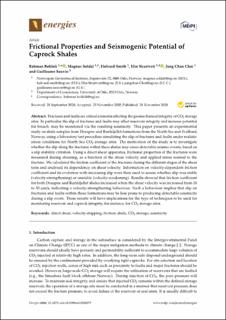| dc.description.abstract | Fractures and faults are critical elements affecting the geomechanical integrity of CO2 storage sites. In particular, the slip of fractures and faults may affect reservoir integrity and increase potential for breach, may be monitored via the resulting seismicity. This paper presents an experimental study on shale samples from Draupne and Rurikfjellet formations from the North Sea and Svalbard, Norway, using a laboratory test procedure simulating the slip of fractures and faults under realistic stress conditions for North Sea CO2 storage sites. The motivation of the study is to investigate whether the slip along the fractures within these shales may cause detectable seismic events, based on a slip stability criterion. Using a direct shear apparatus, frictional properties of the fractures were measured during shearing, as a function of the shear velocity and applied stress normal to the fracture. We calculated the friction coefficient of the fractures during the different stages of the shear tests and analysed its dependency on shear velocity. Information on velocity-dependent friction coefficient and its evolution with increasing slip were then used to assess whether slip was stable (velocity-strengthening) or unstable (velocity-weakening). Results showed that friction coefficient for both Draupne and Rurikfjellet shales increased when the shear velocity was increased from 10 to 50 µm/s, indicating a velocity-strengthening behaviour. Such a behaviour implies that slip on fractures and faults within these formations may be less prone to producing detectable seismicity during a slip event. These results will have implications for the type of techniques to be used for monitoring reservoir and caprock integrity, for instance, for CO2 storage sites | |
